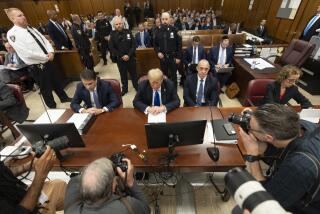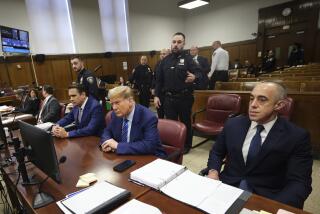City Tries to Predict Westerfield Verdict
- Share via
SAN DIEGO — As the jury in the David Westerfield case completed its eighth day of deliberation on Monday, the biggest guessing game in San Diego has become: What does it mean that the jury has taken so long?
“It means nothing, absolutely nothing,” said Colin Murray, a former prosecutor in private practice. “It would be nice to be able to predict what the jury is doing. It would also be nice to be able to predict who the winner of the ninth race at Del Mar is going to be.”
Other attorneys disagree, saying the deliberations--particularly the extensive testimony that the jurors have asked to have read back to them--indicate either that the panel is deadlocked or that one or more members are not convinced on a verdict.
On Monday, for example, the jury spent most of the day listening to a court employee read aloud the testimony of entomologist David Faulkner, according to Judge William Mudd.
Faulkner, who has testified in hundreds of cases, said that the number and size of bugs found on Danielle van Dam’s mummified body suggest that the body was dumped along a rural road in the days after Westerfield was being watched 24 hours a day by police.
Steven Feldman, Westerfield’s attorney, said this proves that Westerfield could not have been the killer.
According to the notes passed to Mudd by the jury foreman, jurors have not asked to review testimony by two bug experts called by prosecutors who disagreed with Faulkner.
“I can’t imagine they’d go through all this process if they all agreed,” said Justin Brooks, director of the California Innocence Project at California Western School of Law in San Diego. “Nobody spends a week listening to testimony if they’re all in agreement.
“Each additional day they’re out gives more hope to the defense,” Brooks added.
Murray disagreed. “It could be that they’re looking at it to feel good about rejecting the defense theory,” he said.
Westerfield, 50, a self-employed design engineer, is accused of the kidnap and murder of 7-year-old Danielle, whose family lived two doors away in the upscale neighborhood of Sabre Springs. If convicted, he could face the death penalty.
Veteran defense attorney Mary Ellen Attridge said that trying to determine how a jury is leaning “is like reading tea leaves.”
Many juries, she said, complete their task quickly because the issue is one of degree of guilt, not the identity of the criminal, because the evidence against the accused is overwhelming. The Westerfield case, she said, does not fit this mold.
“The majority of cases are not whodunit cases,” she said. “Whodunit cases take longer. A jury in a case like that is likely to be out longer because they have serious issues of fact to decide.”
Although the jury has deliberated for eight days, on several days they were together for only a few hours. As the jury continued its deliberations--and took its lunch break in a newly designated spot in the courthouse to avoid the media--the judge reacted crossly to an editorial in the San Diego Union-Tribune that accused him of acting improperly when he banished from his courtroom the field producer for a radio talk-show that broadcast information from a closed session of the court.
Mudd responded: “I had no idea that, in this community, I was the Saddam Hussein of the 1st Amendment.”
Also on Monday, Mudd refused a request from media attorney Guylyn Cummins to release transcripts of 17 closed sessions, many of which involved disputes between attorneys about whether certain evidence was admissible.
“I don’t need the headaches frankly of picking up the paper each morning and reading stuff that has been excluded from the trial,” Mudd said.
Mudd said he is determined to divulge only information that he has ruled admissible. “What the public has heard is what the jury has heard,” he said.
More to Read
Sign up for Essential California
The most important California stories and recommendations in your inbox every morning.
You may occasionally receive promotional content from the Los Angeles Times.










